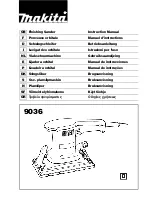
HELPLINE NO 08454 505299
12
ORIGINAL INSTRUCTIONS
• You can buy 40#, 60# sanding paper for
very corst sanding.
• It is best to make a trial run on a scrap
piece of material to determine the
optimum grades of sandpaper for a
particular job.
• If there are still marks on your work
after sanding, try either going back to a
coarser grade and sanding the marks out
before recommencing with the original
choice of grit, or try using a new piece
of sandpaper to eliminate the unwanted
marks before going on to a finer grit and
finishing the job.
7) USING THE SANDER (See Fig. F, G)
This sander can be used for most sanding
operations on materials such as wood,
plastic, metal and painted surfaces.
W
ear safety goggles, dust mask and ear
defenders.
Switch the sander on whilst it is resting on
the workpiece.
T
ake care to hold the whole
area of the base plate on the work.
Move the sander over the surface of the
work in a circular motion with an even,
moderate pressure.
Do not press down too heavily. This will
slow down the motor and could lead to
overheating.
CAUTION:
Where possible, clamp smaller
workpieces to the bench.
NOTE:
If there are still scratches on
your work after sanding, try either of the
following: Go back to a coarser grit and
sand the marks out before recommencing
with the original choice, or try using new
sandpaper of the same grit to eliminate the
unwanted marks before progressing to a
finer grit and finishing the job.
WARNING!
Do not use the sander in wet or damp
conditions.
You can buy 180#, 240#, 320#, 400#
sanding paper for very fine sanding.
Fig. F
Fig. G

































